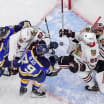The urgency for young goalies to understand the importance of being a good puck-handler, and also about the risk factors involved with playing the puck under pressure, is only growing. Young goalies need to be working on this skill and their reads under pressure as they develop their games.
Coaches like to say the system protects the players, meaning that if our breakout positioning and options are clearly established by the coaching staff, any young player or goalie can be inserted into the lineup and look good as long as he understands the game plan. Making habits of doing things a certain way, having players being in certain spots in a given situation is key to a team that functions well. When everybody implements and respects the plan, things run smoothly, and the team will be able to break out of the zone.
When an NHL goalie stops a puck in the trapezoid behind his net, he should know his options because he only has a split second to read the forecheck and make the right passing play. If he does, he should be more comfortable and make accurate reads and smart decisions. That trust in the system and simple communication can help the goalie, even if puck-handling is not one of his best assets.
A great example of this is what's happening in Calgary. Smith has always been excellent in this area, able to make several plays per game. David Rittich is now getting a chance to play more for the Flames and though he's not as highly skilled as Smith in moving the puck, he's starting to feel more confident at handling it as he trusts the system along with having good communication with his defensemen.
Communication is a key piece to the puzzle.
In fact, I've found that's one of the biggest differences in the game at the NHL level. Most NHL players border on loud when it comes to communicating with their teammates. They insist on it, they are good at it, generally much more so than players at lower levels and in junior.
Knowing what to say to your goalie as a defenseman is imperative.
I remember an incident some time ago when I worked in Calgary. A young player was in the lineup and, luckily, it was only a preseason game. When Miikka Kiprusoff went behind his net to play a puck, the defenseman yelled out, "It's all yours." These words are obviously meaningless for a goaltender who's under pressure by an aggressive forecheck in a noisy arena.
In this situation, predictably, the wrong play was made when Kiprusoff heard his teammate. It was a good example what not to say, a very teachable moment.
When I teach in our goalie camps, I also can't emphasize enough how important it is for a goalie to be a good skater if he wants to be good at handling the puck. If you're not a great skater, I think puck-handling is always going to be a struggle because you can't get there on time to get the puck.
Another detail that's important in handling the puck is to think like a skater.
A goalie should expose as little as possible to a forechecker when he handles the puck. He does this by way of his body position when he is readying to make plays.
Marty Turco was a pioneer in this area, a master at the quick turn, able to go virtually 360 degrees after he faked a forechecker. He could spin and move the puck the other way with a quick pass. Smith learned a lot from Turco when they were together in Dallas.
Not every goalie will be as proficient at puck-handling as Turco or Marty Brodeur, but the sooner young goalies learn what a strength it can be in their games, the better. It's something that will separate them from the pack in tryouts.



















